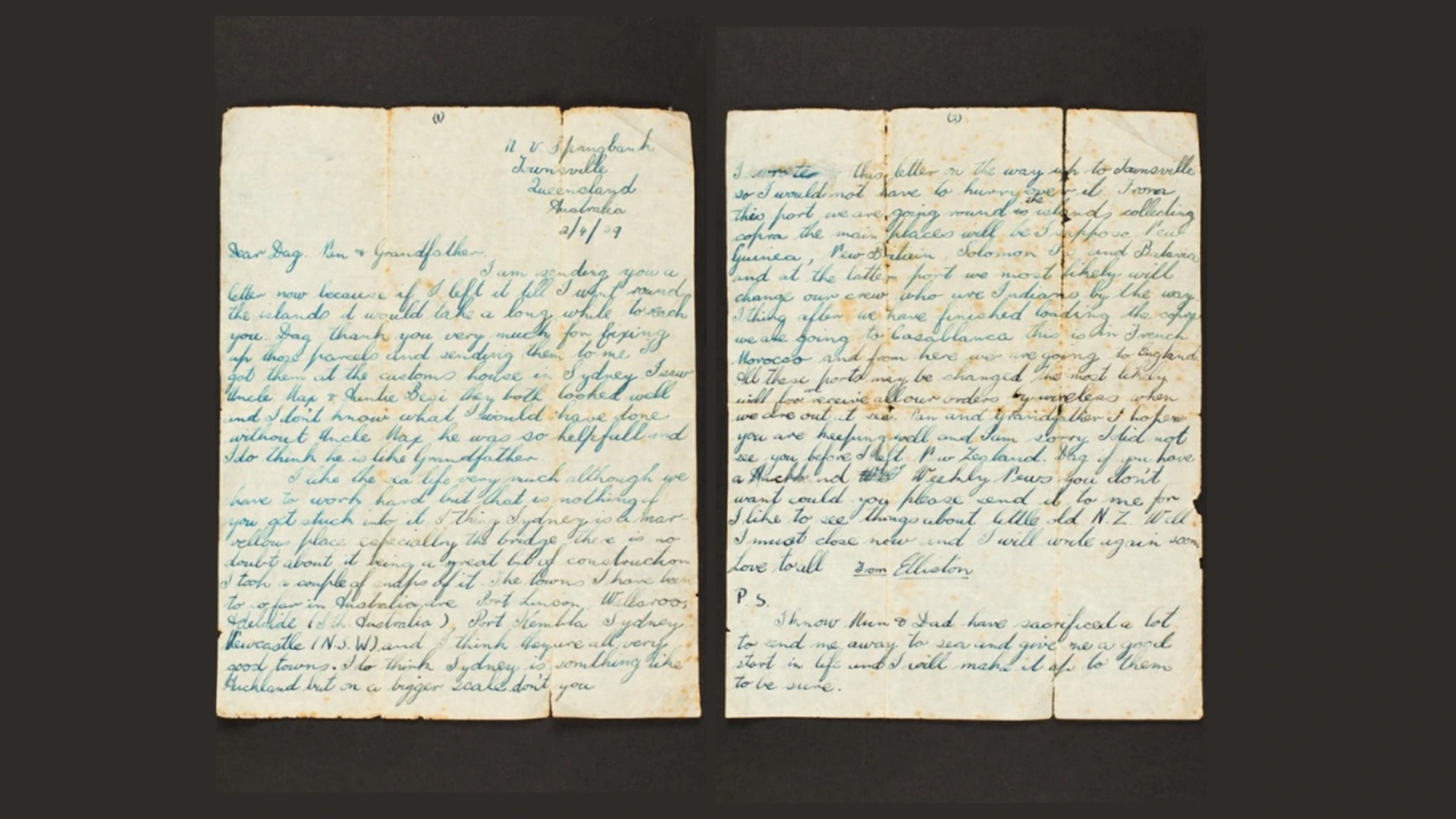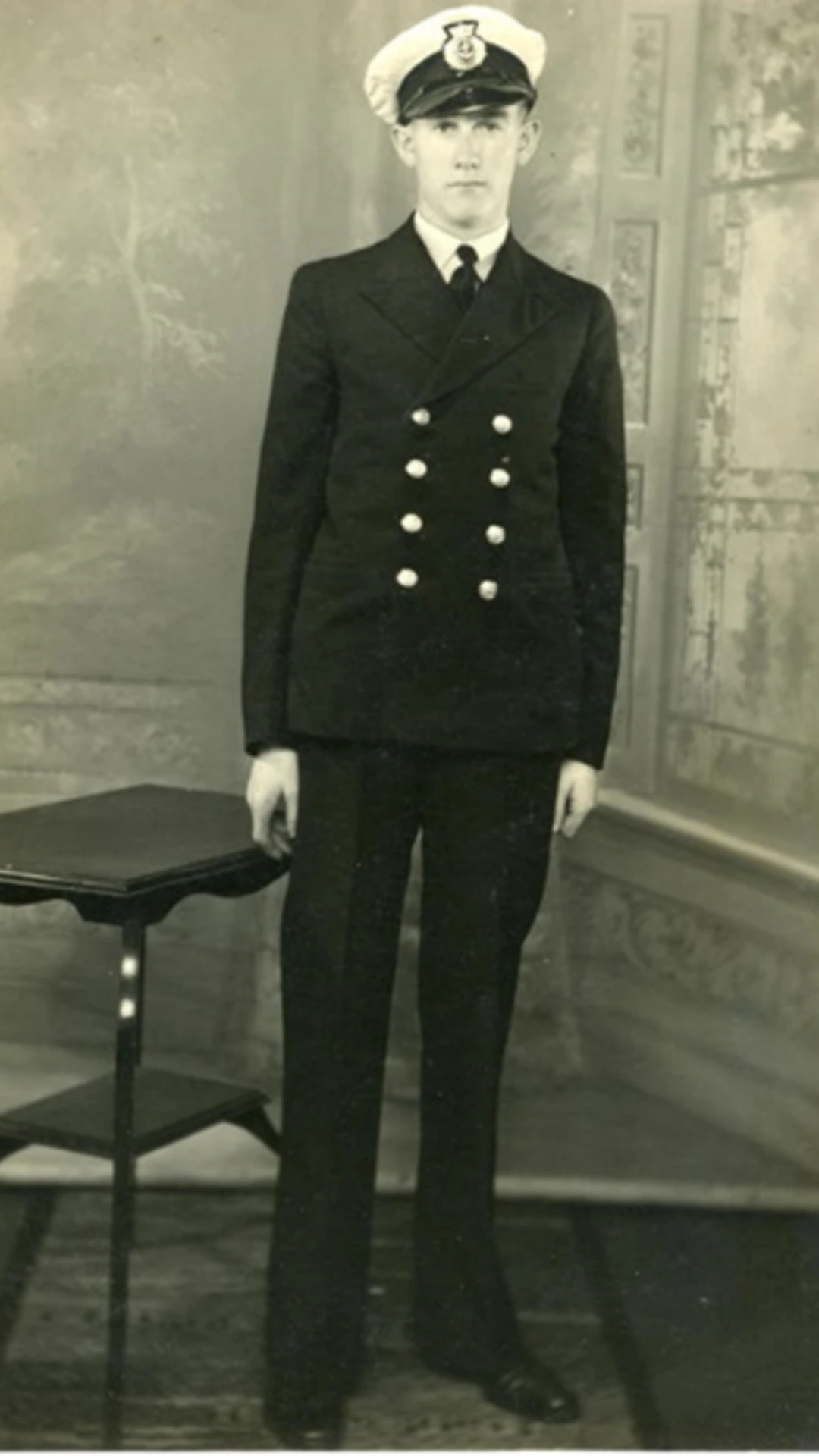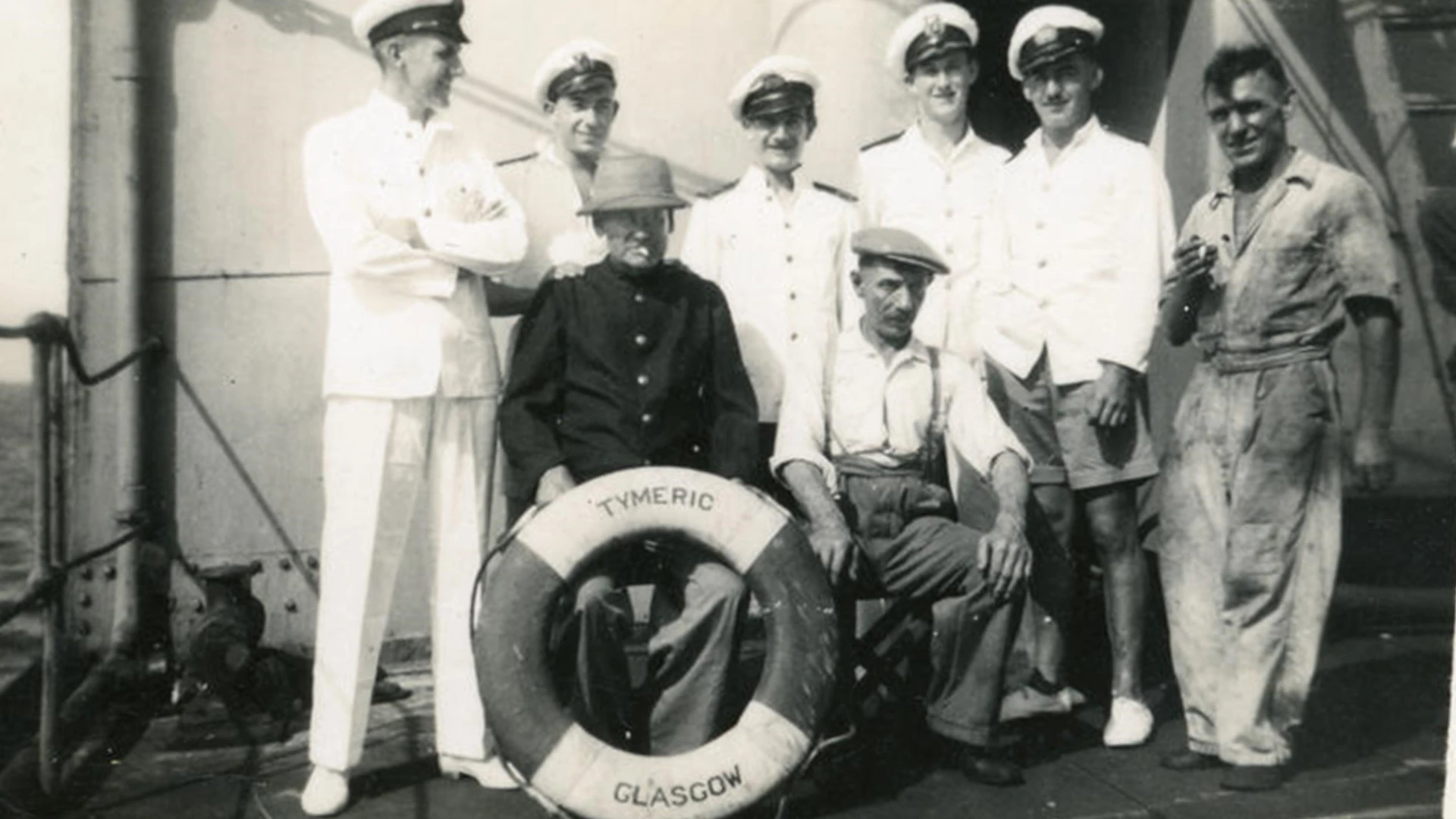Teenager Elliston Dunn wrote this letter onboard MV Springbank a few months before the outbreak of World War II, which resulted in the death of about 60,000 seafarers serving in Allied or neutral merchant ships. Conservatively, 140 were New Zealanders. Dunn was one.

Fig 1: Letter from Elliston Dunn
Early in 1939, Elliston Dunn’s days seemed halcyon. When the 18-year-old wrote to ‘Dag, Nan & Grandfather’ he was voyaging to Townsville, having departed from number 10 wharf at Sydney’s Walsh Bay. Sydney had beguiled him—the city generally, and its bridge in particular: ‘There is no doubt about it being a great bit of construction,’ he assessed. From Queensland his ship was bound for the Pacific Islands to upload copra, for delivery to England. Despite the hard work, sea life was for him, Dunn told his aunt Dagmar and grandparents Lavinia and Paul von Zalinski over in Auckland. It was likely, he also noted, that en route to Europe from the Pacific Springbank would stop off in Morocco, would berth in Casablanca. In the city founded by the Amazigh people around the seventh century BCE, Dunn might have stretched his legs round the old medina, might have eaten kefta tagine, smoked shisha, sipped a qahwa, maybe bought his mother Maxime and sister Judith pairs of beaded slippers in a souk, before reboarding and making passage for London where he and Springbank arrived on the 26 July 1939.
It was all a long way from the New World of Ōtepoti Dunedin where Dunn had joined the Merchant Navy after leaving King’s High School in 1938, and briefly worked for a local engineering firm. His parents looked to have been loving and loved—Dunn postscripts his letter: ‘I know Mum & Dad have sacrificed a lot to send me away to sea and give me a good start in life and I will make it up to them to be sure.’ In January 1939 the ‘Personal and Social’ column of the Otago Daily Times carried the news that ‘Mrs Leslie Dunn of St Clair, whose son Elliston has entered the service of the mercantile marine as a cadet, entertained the cadets from his vessel during the weekend.’

Fig 2: freshly minted cadet officer Elliston Dunn, 1939
Other intimations of the Dunn family’s life and society occasionally surfaced in the city’s daily record; Mr and Mrs Leslie Dunn gave a delightful coming out dance at the Strand Salon in George Street in 1937, in honour of daughter Judith, who wore white taffeta and carried an ivory fan; Mr Leslie Dunn, manager of the Dunedin branch of the Nestles Anglo-Swiss Condensed Milk Company travelled to Auckland one Saturday in May 1938; Mrs Leslie Dunn hosted a tea party at the Otago Women’s Club in July 1938; at the prize-giving of Dunn minor’s alma mater King’s High School in 1940 guest speaker Dean Cruickshank of St Paul’s Cathedral offered boys three rules by which to live: be reliable, be polite, and ‘Strive to be an English gentleman. Don’t confuse gentlemanliness with being fashionable. Being fashionable is only elevated vulgariy. Being a gentleman is the solid mahogany; being fashionable is only the veneer,’ the Otago Daily Times quoted.

Fig 3: Elliston Dunn (3rd R) onboard SS Tymeric, circa 1940
When New Zealand declared war on Germany on 3 September 1939 Dunn’s precise whereabouts are unknown. But by 1940, according to the Auckland Star newspaper, he was on the French coast, at Dunkerque when a hundreds-strong flotilla spirited away 338,000 British and French troops as German forces closed in. A few months later—on Saturday 23 November—Dunn was serving in SS Tymeric transporting 6000 tons of coal between Hull and Buenos Aires, flying the red ensign of the British Empire and Dominions, part of a convoy in the North Atlantic, when the German submarine U-123 sent a torpedo into the ship’s stern. Dunn, then 19, was the youngest of the seventy-one crew members who perished.
Springbank’s captain Thomas Fraser was one of about three survivors eventually rescued by HMS Sandwich, and dropped off in Liverpool. He wrote to Maxime and Leslie Dunn in Ōtepoti, describing their son’s fate: ‘The vessel was struck by a torpedo from a submarine at 3.30 in the morning. She turned over and sank in three minutes. Most of the staff and the Indian crew, who were below decks at the time, had no chance whatever. I myself went down with the ship, but as I was in the bridge at the time I eventually came to the surface and managed to get on a raft. There I found one of the wireless operators and a gunner with 20 of the Indian seamen, but all of the Indians eventually died from exposure. When daylight came there was nothing to be seen but a little wreckage. The weather was stormy at the time, and the whole thing happened so suddenly in the dark that nobody but those on deck at the time had any change of saving themselves.’
The horrific scene wasn’t unusual; attacks at sea (and in port) made being in the Merchant Navy in World War II perilous. In the same month Tymeric was torpedoed 350 miles west-northwest of Ireland, U-123 sank another four merchant ships in the vicinity; by the war’s end the U-boat had sunk 44. In all, roughly 4,800 Allied and neutral merchant ships were destroyed in the war as a result of enemy action. Lucky survivors like Fraser received some callous treatment from their profit-preoccupied employers; British shipping companies ceased paying crew from the moment a ship went down—until May 1941, when the Essential Work Order passed by parliament guaranteed merchant seafarers a wage for time spent in lifeboats or captivity.
In 1942 Dunn’s parents presented King’s High School with £70, the residue of their son’s estate, suggesting it be used to establish a prize. And then 50 years later—in 1993—Elliston’s brother Bernie presented a ship’s bell from the Merchant Navy minesweeper Star of Britain to the school, in memory of the 14 alumni who had died in World War II. When Dunn had first crewed out his mother had asked him to bring her back a bell. After the war, a friend salvaged one from a shipyard, and kept good on Dunn’s promise.
Images:
Fig 1: Letter from Elliston Dunn to ‘Dag, Nan & Grandfather’, 2 April 1939. NZMM 2022.62.3*
Fig 2: Apprentice/cadet officer Elliston Charles Grainger Dunn in Merchant Navy uniform, studio portrait shot, 1939. NZMM 2022.62.5*
Fig 3: Elliston Dunn onboard SS Tymeric, ca., 1940. NZMM 2022.62.8*
*Gift of the Dunn family
References:
“Coming-Out Party”, Otago Daily Times, 6 July 1937, 6
“High Schools’ Board”, Otago Daily Times, 20 Feb 1942, 7
‘On Leaving School”, Evening Star, 13 Dec 1940, 4
“Personal”, Otago Daily Times, 16 May 1938, 10
“Personal and Social”, Otago Daily Times, 21 Jan 1939, 26
“Personal and Social”, Otago Daily Times, 11 October 1938, 21
“Reported Missing”, Evening Star, 11 December 1940, 10
“Ship’s bell presented to school”, Otago Daily Times, 6 Mar 1993
“Three Survivors’, Nelson Evening Mail, 24 Jan 1941, 3